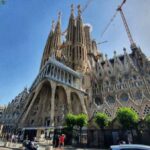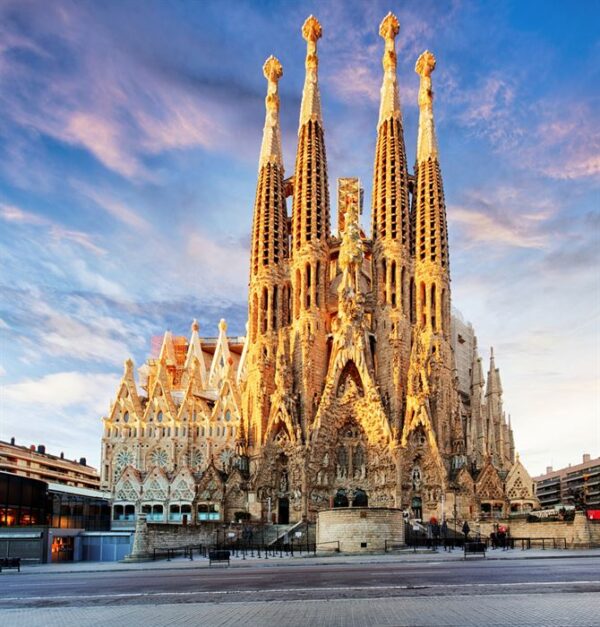
The Sagrada Familia stands as a symbol of Barcelona's artistic and architectural heritage, captivating millions of visitors each year. Its intricate façade and breathtaking interiors reflect the visionary genius of Antoni Gaudí, making it one of the most iconic landmarks in the world.
As you explore its towering spires and stunning mosaics, you'll understand why so many are enchanted by this masterpiece. Discover the Majestic Sagrada Familia and immerse yourself in the beauty of this unfinished basilica, where every detail tells a story of faith, creativity, and dedication.
Exploring the Architectural Wonders of the Sagrada Familia
The Sagrada Familia is not just a basilica; it is a profound testament to the imagination and artistry of its creator, Antoni Gaudí. As visitors walk through its hallowed halls, they are greeted by a stunning array of architectural styles that blend Gothic and Art Nouveau elements, creating an otherworldly atmosphere. Each façade tells a different story, inviting guests to delve deeper into the spiritual and cultural significance of this monumental work.
One of the most striking features of the Sagrada Familia is its towering spires, which symbolize various aspects of Christianity. Visitors can marvel at the intricate details of each spire, which are designed to reflect the natural world. Here are some highlights:
- Nativity Facade: Celebrates the birth of Jesus and is adorned with life-like figures.
- Passion Facade: Represents the suffering of Christ, marked by stark and angular designs.
- Glory Facade: Still under construction, it will symbolize the resurrection and glory of Christ.
Every corner of the Sagrada Familia reveals Gaudí's innovative techniques and his deep connection to nature. The columns inside resemble tree trunks, branching out to support the ceiling, creating a serene forest-like atmosphere. This unique approach not only enhances the aesthetic beauty but also serves as a metaphor for the interconnectedness of life and faith.
As you wander through this architectural marvel, be sure to take note of the stunning stained glass windows, which fill the interior with a vibrant spectrum of colors. The interplay of light and shadow within the basilica is a reminder of the divine presence, making every visit a transformative experience. The Sagrada Familia truly encapsulates the essence of Barcelona’s cultural identity and stands as a beacon of creativity and devotion.
The History Behind the Sagrada Familia: A Journey Through Time
The Sagrada Familia's history is intricately woven with the life and vision of its architect, Antoni Gaudí. Construction began in 1882, with Gaudí taking over the project in 1883. His commitment to this grand undertaking transformed it into a lifelong mission, reflecting a deep connection to his faith and the natural world. Gaudí's unique architectural style, characterized by organic forms and vibrant colors, began to flourish during this period, laying the groundwork for what would become a monumental symbol of Barcelona.
Over the years, numerous challenges have plagued the construction of the Sagrada Familia, including the Spanish Civil War, which halted progress for almost a decade. Despite these setbacks, the project continued to evolve, with various architects contributing to its development following Gaudí's untimely death in 1926. Today, the basilica is a collaborative effort, with techniques from the 21st century being utilized to bring Gaudí's vision to life while maintaining fidelity to his original designs.
The journey through time reflects not only the architectural advancements but also the cultural significance of the Sagrada Familia. As the basilica nears its completion, expected around 2026 for its centennial, it aims to encapsulate the essence of Barcelona's heritage and the enduring spirit of creativity. This magnificent structure now stands as a testament to resilience, faith, and the relentless pursuit of beauty.
Today, millions flock to this iconic landmark, each visitor contributing to the living history of the Sagrada Familia. As you explore its vast interiors and intricate exteriors, you'll discover a shared journey through time—an ongoing story that continues to inspire awe and admiration. The Sagrada Familia not only represents an architectural masterpiece but also embodies the collective dreams and aspirations of generations.
Understanding the Symbolism of the Sagrada Familia's Design
The design of the Sagrada Familia is rich in symbolism, reflecting deep religious themes and Gaudí's unique vision. Each element within the basilica has a meaning, inviting visitors to contemplate the connection between architecture and spirituality. This profound intention makes the Sagrada Familia not only a masterpiece of artistry but also a living expression of faith.
Gaudí ingeniously incorporated natural forms into his design, using them as symbols to convey theological concepts. The use of geometric shapes and organic motifs serves to illustrate the harmony between nature and divinity. Some key aspects of this symbolism include:
- Nature as a Divine Creation: The columns resembling trees symbolize the connection between the earthly and the divine.
- Light as a Symbol of Faith: The stained glass windows depict the spectrum of life, representing the presence of God through light.
- Vertical Lines in Architecture: The soaring towers point upwards, symbolizing the aspiration of humanity towards the divine.
Furthermore, the Sagrada Familia’s façades serve distinct purposes, each narrating a part of Christ's life. The narratives etched into the stone reflect moments of joy and sorrow, emphasizing the multifaceted nature of faith. This deliberate storytelling through design encourages visitors to experience a deeper understanding of Christian teachings.
In essence, the Sagrada Familia stands as a testament to Gaudí's belief that architecture should inspire reflection on the divine. Through its intricate details and symbolic elements, the basilica invites all who enter to embark on a spiritual journey, exploring the interplay between creativity, faith, and the natural world.
Visitor's Guide: Best Times to Experience the Sagrada Familia
When planning your visit to the Sagrada Familia, timing can greatly enhance your experience. The best times to visit are typically early morning or late afternoon. During these hours, the light streaming through the magnificent stained glass windows creates a stunning visual display, illuminating the basilica's interior with vibrant colors. Additionally, these times tend to be less crowded, allowing for a more intimate experience with Gaudí's masterpiece.
Consider visiting on weekdays rather than weekends, as the influx of tourists can significantly increase during the latter. To avoid long lines, you might also want to purchase your tickets online in advance. Here are some tips for optimal visiting:
- Morning visits: Arrive right when the doors open for a serene atmosphere.
- Late afternoon: Experience the changing light and fewer crowds.
- Weekdays: Aim for Tuesday through Thursday for a more peaceful exploration.
Another important factor is the season. Spring and fall are ideal due to milder weather and fewer tourists compared to the summer months. Visiting during these seasons not only enhances your comfort but also allows you to appreciate the architectural details without the distraction of overwhelming crowds. Embrace the beauty of the Sagrada Familia in a setting that complements its grandeur.
Lastly, staying informed about special events or religious services can also enrich your visit. The Sagrada Familia often hosts masses and concerts, providing a unique opportunity to experience the basilica in a different light. Check the official website for schedules, ensuring you don't miss a chance to witness this architectural wonder in a vibrant, active context.
The Artistic Influence of Antoni Gaudí on the Sagrada Familia
Antoni Gaudí's artistic influence on the Sagrada Familia is profound, merging architectural innovation with deep spiritual significance. His vision was to create a basilica that transcended conventional design, and he achieved this by incorporating natural forms and organic shapes. For Gaudí, architecture was not merely a profession but a spiritual practice, and this is evident in every detail of the Sagrada Familia, where nature and faith harmoniously coexist.
One of the hallmarks of Gaudí's artistry is his use of color and light. The stained glass windows, designed to interact with sunlight, fill the basilica with a kaleidoscope of colors that enhance its ethereal quality. This masterful play of light not only beautifies the space but also serves as a metaphor for the divine, making the interior feel alive and spiritually uplifting. The incorporation of light in his design reflects his belief in the transformative power of nature and faith.
Gaudí's distinctive style is also characterized by the absence of straight lines, which he believed limited the expression of creativity. Instead, he favored curves and organic shapes, mimicking the forms found in nature. This approach can be seen in the basilica's columns, which resemble tree trunks branching out to support the soaring ceilings. Such innovative engineering not only creates a unique aesthetic but also symbolizes the connection between the earth and the divine, resonating with visitors on multiple levels.
Ultimately, Antoni Gaudí's artistic influence on the Sagrada Familia positions it as a testament to the unity of art, architecture, and spirituality. His vision continues to inspire architects and artists today, showcasing how creativity can elevate our understanding of faith and existence. As work progresses towards its anticipated completion, the Sagrada Familia remains a living canvas, reflecting Gaudí's unmatched genius and the enduring quest for beauty in the sacred.
Why the Sagrada Familia is a UNESCO World Heritage Site
The Sagrada Familia is designated a UNESCO World Heritage Site due to its unique architectural style, which is a fusion of Gothic and Art Nouveau influences. This blend not only showcases Antoni Gaudí's innovative approach but also reflects the cultural significance of Barcelona as a center of artistic development. The basilica's design embodies spiritual narratives that resonate with visitors, making it a key symbol of the city's identity.
Several criteria contribute to the Sagrada Familia's UNESCO status, including:
- Exceptional Universal Value: Represents groundbreaking architectural advancements.
- Artistic Mastery: Exhibits a level of creativity that has influenced architecture worldwide.
- Cultural Heritage: Reflects the historical evolution of religious architecture in Europe.
Furthermore, the Sagrada Familia is notable for its ongoing construction, which has persisted for over a century. This continuous evolution not only preserves Gaudí's vision but also reflects the dedication of artisans and architects who strive to complete this masterpiece. As it nears its anticipated completion, it stands as a testament to the enduring spirit of creativity and faith.
In summary, the Sagrada Familia's designation as a UNESCO World Heritage Site is a recognition of its architectural brilliance, cultural impact, and spiritual significance. Each visit to this iconic landmark offers a glimpse into a unique architectural journey, inviting guests to connect with the artistic heritage of Barcelona and the legacy of Antoni Gaudí.
 Inside the Marvels of Barcelona: Exploring the Interior of the Sagrada Familia
Inside the Marvels of Barcelona: Exploring the Interior of the Sagrada Familia The Fascinating History of Barcelona's Sagrada Familia: A Brief Overview
The Fascinating History of Barcelona's Sagrada Familia: A Brief OverviewIf you want to know other articles similar to Discover the Majestic Sagrada Familia you can visit the category WHERE YOU CAN GO.
Leave a Reply










Read more!